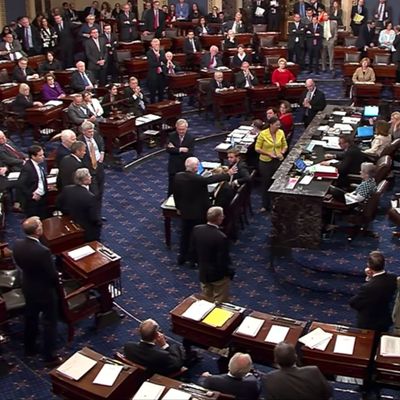
There’s been a lot of justified talk about how the Biden COVID-19 stimulus bill that passed the Senate over the weekend represents one of the largest expansions of federal assistance to low-to-moderate-income families since, well, pick your precedent, from a list that includes FDR’s New Deal and LBJ’s Great Society. The bill’s ultimate legacy, of course, will be determined later. Will its many temporary provisions (notably, boosts in the child tax credit and the Earned Income Tax Credit) be made permanent? And what will follow it as the Biden administration’s next act, which will presumably address the broad outlines of the health-care system and anti-poverty programs?
But even at this preliminary stage of the 46th presidency, we’re seeing quite the turnaround from the social-policy trajectory of the 45th. Just 1,320 days ago, the Trump-and-congressional-Republican plan to partially repeal the Affordable Care Act and wreck Medicaid as we’ve known it ran aground on a series of Senate votes, culminating in a 49-51 vote on a “skinny repeal” of Obamacare after John McCain’s dramatic late-night thumbs-down decision. That this same body has now approved, by a 50-49 vote, a bill that Bernie Sanders called “the most significant piece of legislation to benefit working families in the modern history of this country” shows how relatively small changes in the composition of Congress and a narrow Electoral College victory can have huge consequences.
The focus on Obamacare throughout the failed 2017 GOP effort to pass a budge- reconciliation bill (precisely what Congress is now in the process of doing) should not obscure the fact that the battle was yet another in a long series of GOP efforts to disable the social-safety net, among them the Reagan budget of 1981, the Gingrich budget of 1995, the Bush budgets of the early 2000s, and the Ryan budgets of the Obama years. While the ACA’s private-health-insurance exchanges and individual mandate were indeed targets for the Trump administration and its congressional allies, it was Obama’s expansion of Medicaid eligibility that most upset conservatives. Accordingly, the reversal of that expansion and an ultimate end to federal responsibility for Medicaid were the long-term goals of GOP “repeal and replace” bills from the House-passed American Health Care Act to the Cassidy-Graham bill that was the Senate’s final shot at health-care policy before Republicans shifted to tax cuts near the end of 2017.
The Trump administration continued to chip away at Medicaid services through regulations for the rest of its tenure, even as voters in five red states approved expansion of the program by ballot initiative. But there wasn’t much question that the future of Obamacare, Medicaid, and the anti-poverty programs so often targeted by Paul Ryan would be determined by the outcome of the 2020 elections. Indeed, any period of extended Republican control of the White House and Congress would have very likely led the GOP back to their fondest fantasies: an assault on the “middle class entitlements” of Medicare (also a target of Obama-era Ryan budgets) and Social Security (last attempted by George W. Bush in 2005).
It’s in that context that the significance of the American Rescue Plan and its sponsors should be assessed: in terms not just of what it contains, but of the very different path the country might be on had Republicans retained power last November. Even if the GOP claws back control of Congress in 2022 and the White House in 2024, they will have to cope with the popularity of Biden’s proposals and a more tightly woven safety net, whose unraveling will be that much more difficult. It could matter a lot.






























